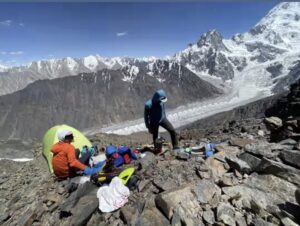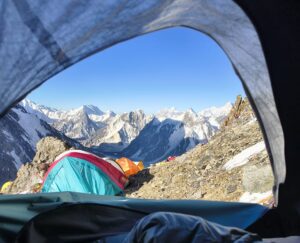Let’s face it: the 14×8000’ers challenge is not what it used to be. So what about doing the next 14 highest peaks instead?
Crowds, too much support, and tragedies such as the one that occurred on K2 two weeks ago have caused a backlash against collectors’ obsessions with records at the expense of everything else, including human life.
Looking for ideas, Eberhard Jurgalski and the 8,000ers.com team have come up with a proposal: The Second Fourteen.
Escape the crowds
“Climbing all the 7,000’ers in the world may be too much for one person in a lifetime, but perhaps the 14 highest 7,000’ers may be an attractive alternative for those with a wilder challenge in mind,” said Jurgalski said. “The Second 14 are lonely mountains, rarely visited. Some have not been attempted for decades.”
To increase the appeal, they have updated a table with all peaks above 6,650m, including recent geographical research and notes on first ascents. The list includes both little-known peaks and those that are wrapped in mountaineering history, adventure, and difficulty.
The Second 14
Starting with the highest, the Second 14 are: Gyachung Kang, Annapurna II, Gasherbrum IV, Himalchuli, Disteghil Sar, Ngadi Chuli, Kunyang Chhish, Masherbrum, Nanda Devi, Chomo Lonzo, Batura Sar, Rakaposhi, Namcha Barwa, and Kanjut Sar.
Check the list here. As with the 8,000’ers, they lie in Nepal, Pakistan, and Tibet. There’s also one in India, the spectacular Nanda Devi. As for first ascents, these lower but difficult peaks are a specialty of Japanese alpinists.
Gyachung Kang (7,952m) is the highest peak straddling the Nepal-Tibet border, besides Everest and Cho Oyu. In fact, it is located between the two 8,000 giants. Approached from Gokyo, it was first ascended by Kiyoto Sakaizawa and Yukihiko Kato of Japan and Pasang Phutar Sherpa of Nepal in 1964. The normal route goes up the southeast ridge and is moderately technical.
Annapurna II (7,937m) Is separated from the main Annapurna massif and features a long, rocky summit ridge. Chris Bonington and Sherpa Ang Nyima first climbed it in 1960. The two first ascended Annapurna IV from the north then continued to Annapurna II via the west ridge.

Annapurna II from its north side. Photo: Wikipedia
Only one with a winter ascent
Annapurna II is the only one of the Second 14 that features a winter ascent. Philipp Kunz of Germany and Sherpas Lhakpa Thinduk, Temba Nurbu, and Lhakpa Ongyal of Nepal succeeded in February 2008.
We would need a book to properly cover the Legendary Gasherbrum IV (7,925m) and its mythical Shining Wall, or the epic climbs by Bonatti and Kurtyka. Let’s just say that Dmitry Golovchenko and Sergey Nilov are currently fighting their way up a new route on the south side.
Himalchuli lies south of Manaslu while Chomo Lonzo is near Makalu. The former has three points. The 7,893m eastern one is the highest and was first climbed by Hisashi Tanabe and Masahiro Harada of Japan in 1961.
Chomo Lonzo also features three distinct peaks and is right on the Tibetan border. The Kangshung Valley in Tibet offers an impressive view of it. Its southern 7,804m summit is the main peak. Jean Couzy and Lionel Terray of France first summited Chomo Lonzo in 1954 from Sakietang La, the col separating the mountain from Makalu.

Everest and surrounding peaks from the north, with the Tibetan plateau in front, featuring Makalu and Chomo Lonzo. Photo: Wikipedia
A Pakistan giant
Disteghil Sar (or Distaghil Sar), in Shimshal, is the 7th highest peak in Pakistan. It has a three-kilometer-long ridge above 7,400m, leading to three distinct summits: Northwest, 7,885m; Central, 7,760m; and Southeast, 7,696m or 7,535m, depending on the source. Gunther Starker and Diether Marchart of Austria made the first ascent in 1960, via the south face and the southwest ridge.
Ngadi Chuli (7,871m), also known as Peak 29, is immediately south of Manaslu. Despite its great height, it has only had a couple of ascents. The first was in 1979 by the Polish climbers Ryszard Gajewski and Maciej Pawlikowski via the west buttress. The climb reputedly involves some Class V rock climbing on the upper sections.
Back in Pakistan, Kunyang Chhish (7,852m) is on the north side of the huge Hispar Glacier. This impressive peak rises almost 4,000 vertical meters above its southern base camp on the Kunyang Glacier, and 5,500 meters (!) above the Hunza Valley.

Kunyang Chhish. Photo: Wikipedia
One of the great unsolved problems
Masherbrum (7,821m), the peak called K1 by British topographers, needs no introduction, but it requires a first-class alpinist to deal with it. Its Northeast Face remains one of the great unsolved problems of the Himalaya. It was last attempted in 2014 by the late David Lama and Hansjorg Auer with Peter Ortner. Lama famously described it as “the North Face of the Eiger with a Cerro Torre on top of it.” Marek Holecek and Radoslav Groh of the Czech Republic attempted the West Face last year.
Nanda Devi (7,816m) requires no introduction, either. It’s the second-highest mountain in India after Kangchenjunga, on the border of Sikkim. Early 19th-century topographers briefly considered it the world’s highest peak. Nanda Devi also has a lower eastern summit, called Nanda Devi East ( 7,434m), or Sunanda Devi. A ridge almost three kilometers long and nearly 7,000m high connects the two summits.
Batura Sar (7,795m) or Batura I is the highest peak in the so-called Batura Wall, which also features Muchu Chhish (unclimbed despite repeated attempts by Czech climbers). Baruta Sar is the second most prominent peak in the Karakoram. It has a tragic history: All members of the first expedition in 1959 died, probably in an avalanche. Hubert Bleicher and Herbert Oberhofer eventually managed the first ascent in 1976.
Another Japanese success
Rakaposhi (7,788m) is one of the most photographed mountains in Pakistan because it seems to rise scenically right behind the town of Gilgit — although it is actually 100km away. Mike Banks and Tom Patey bagged the first ascent in 1958 via the Southwest Buttress. In July 2019, Kazuya Hiraide and Kenro Nakajima of Japan completed the first ascent of its South Face/Southeast Ridge via a beautiful new route that won them a Piolet d’Or. Theirs was the latest new route opened on the Second 14, according to Jurgalski.

Kazuya Hiraide on the summit of Rakaposhi. Photo: Ishii Sports
Namcha Barwa (7,782m) is possibly the least-known peak on the list. Located in southeastern Tibet, it is rarely visited. It rises 5,000–6,800 meters above the Yarlung Tsangpo River. Chinese alpinists began attempting the peak in the 1980s. After three unsuccessful attempts, they joined forces with the Japanese and eventually climbed the peak in siege style in 1991.
Kanjut Sar I (7,760m) is located in Karakoram’s Shimshal Valley. It was first climbed in 1959 by Camillo Pellissier and has had some routes added since then.
No woman has climbed one of these in 40 years
“Only three mountaineers have climbed two of [the Second 14],” said Jurgalski. “Zygmunt Andrzej Heinrich of Poland ascended Kunyang Chhish and Batura Sar, Timothy Macartney-Snape of Australia climbed Annapurna II and Gasherbrum IV, and Masafumi Teramoto of Japan climbed Nanda Devi and Kanjut Sar.”
He notes that only two of the Second 14 have been climbed by women: Rakaposhi by Anna Czerwinska and Krystyna Palmowska in 1979, and Nanda Devi by Indian climbers Chandra Prabha Aitwal, Harshvanti Bisht, and Rekha Sharma in 1981. For over 40 years, no woman has climbed any of the Second 14.

Krystyna Palmowska and Anna Czerwinska. Photo: 7sensestravel.ge
Nuptse not a “true mountain”
Jurgalski deliberately left out two very well-known peaks: Annapurna III, where a Ukrainian team completed a Piolet d’Or-winning new route in 2022, and Nuptse, the third peak in the Khumbu threesome that includes Everest and Lhotse.
The reason? The team has applied the same geographic criteria to these as they did for the 8,000’ers. They require more than 7 % Orometrical Dominance (independence) to consider a peak a “true mountain.” Gasherbrum III has just 4.47 % and Nuptse 3.88%.
Nuptse (7,861m) is not a great place to avoid the crowds either, since it shares its Base Camp with Everest. But it gives a great opportunity for technical high-altitude climbing. Last spring, Christian De Jong and Prakash Sherpa climbed Nuptse alpine style.
Eberhard Jurgalski and the 8,000’ers.com team are doing excellent work compiling facts about high-altitude mountaineering. You can explore information about the Second 14 in four separate lists here.





